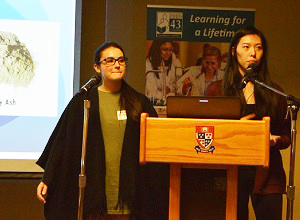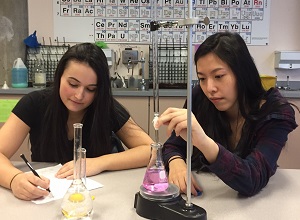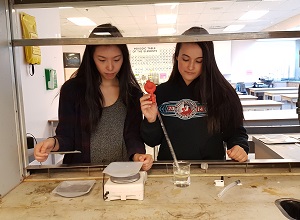 School District No. 43 (Coquitlam) is proud to announce that Grade 12 students Alexa Durand and Brenda Shen from Riverside Secondary School have been selected as the school district's finalists of the Student SpaceFlight Experiments Program (SSEP) for their proposal titled "The effect of microgravity on concrete used in building structures" and will have their experiment proposal travel to the International Space Station (ISS) in the Spring/Summer of 2017 where it will be conducted by astronauts.
School District No. 43 (Coquitlam) is proud to announce that Grade 12 students Alexa Durand and Brenda Shen from Riverside Secondary School have been selected as the school district's finalists of the Student SpaceFlight Experiments Program (SSEP) for their proposal titled "The effect of microgravity on concrete used in building structures" and will have their experiment proposal travel to the International Space Station (ISS) in the Spring/Summer of 2017 where it will be conducted by astronauts.
The experiment will study how fly ash concrete performs in microgravity and determine if there are any changes in the density, compression and tensile strength compared to fly ash concrete cured on earth. Concrete is typically composed of cement, water, and aggregate (rock sand, or gravel). The fly ash concrete that will be utilized in this experiment replaces 25 percent of the cement component with fly ash. Fly ash is a byproduct of coal combustion and the use of fly ash in concrete allows this byproduct to be reused instead of being released into the atmosphere or placed in landfills. Fly ash concrete is proven on earth to have many benefits including greater strength, durability, and increased workability over time. This research may not only be helpful in future buildings in microgravity situations but may also provide valuable information that may aid construction practices on earth.
 "Words cannot express how honouring it felt to be chosen. Brenda and I have put a lot of work into this project, we have learned many new skills during this experience, and I am very excited so see what comes next in this journey," said Alexa Durand.
"Words cannot express how honouring it felt to be chosen. Brenda and I have put a lot of work into this project, we have learned many new skills during this experience, and I am very excited so see what comes next in this journey," said Alexa Durand.
"Having our project selected to go to the ISS is a huge deal for us! Considering the amount of time and work we put in, it's a great feeling knowing that it all paid off and that our experiment could potentially have an impact in future space endeavours," said Brenda Shen.
The experiment was selected from 277 proposals that were submitted by more than 1,600 SD43 students, and one of three submissions which were selected as finalists by a group representing SD43 and the project's supporting organizers. The final three submissions were submitted to the SSEP Step 2 Review Board who made the final selection.
"I am so incredibly proud of Brenda and Alexa. Their experiment is both original and scientifically rigorous, and they spent many hours researching microgravity and conducting experiments on earth with fly ash concrete to help form their hypothesis," added Devon Ross, the team's educator mentor.
"SSEP allowed for many varied opportunities to learn alongside our students and the community. Teachers and students were equally passionate about the integrated and authentic learning experiences and are already looking for the next similarly engaging STEAM opportunities," collectively commented SD43's SSEP program co-leaders Wooje Choi and Brent Raabe, science teachers at Dr. Charles Best Secondary School, and Michelle Ciolfitto, Learning Services Coordinator.
"For the past three months we have witnessed the incredible ingenuity and creativity of our students who participated in this program," said Kerri Palmer Isaak, Chair of the SD43 Board of Education. "I commend all 1,600 students who took part, and extend my congratulations on behalf of the Board of Education to Miss Durand and Miss Shen from Riverside Secondary."
SD43 is one of only 2 Canadian participants chosen for this mission, the other being out of Manitoba. Support for SD43 students and schools to take part in the project has been generously provided by several organizations including Simon Fraser University, Magellan Aerospace (a Canadian National Partner on SSEP), Fingerfood Studios, Urthecast, and MacDonald, Dettwiler and Associates.
The experiment will be part of the SSEP Mission 11 payload to the ISS, and is currently planned to launch on a SpaceX Falcon-9 rocket from Cape Canaveral Air Force Station in Florida, adjoining the Kennedy Space Center, in the Spring/Summer 2017. The subsequent data analysis from the experiment will be performed by SD43 students.
SSEP uses a commercial spaceflight payload, which will contain the SSEP student experiments, and which will be placed aboard ferry vehicles for transfer to the ISS. The Student Spaceflight Experiments Program is enabled through NanoRacks, LLC, which is working in partnership with NASA under a formal Space Act Agreement as part of the utilization of the ISS as a National Laboratory.
More details and updates on the project can be found on the SD43 website at: www.sd43.bc.ca/pages/space.aspx.
The Student Space Flight Experiments Program (SSEP) (http://ssep.ncesse.org) is undertaken by the National Center for Earth and Space Science Education (NCESSE) http://ncesse.org) in partnership with Nanoracks, LLC. This on-orbit educational research opportunity is enabled through NanoRacks, LLC, which is working in partnership with NASA under a Space Act Agreement as part of the utilization of the International Space Station as a National Laboratory.